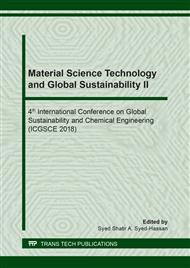[1]
Muthu, R. N., Rajashabala, S., & Kannan, R. (2015). Synthesis and characterization of polymer (sulfonated poly-ether-ether-ketone) based nanocomposite (h-boron nitride) membrane for hydrogen storage. International Journal of Hydrogen Energy, 40(4), 1836-1845.
DOI: 10.1016/j.ijhydene.2014.11.136
Google Scholar
[2]
Wang, S., & Min, K. (2010). Solid polymer electrolytes of blends of polyurethane and polyether modified polysiloxane and their ionic conductivity. Polymer, 51(12), 2621-2628.
DOI: 10.1016/j.polymer.2010.04.038
Google Scholar
[3]
Rani, M. S. A., Rudhziah, S., Ahmad, A., & Mohamed, N. S. (2014). Biopolymer electrolyte based on derivatives of cellulose from kenaf bast fiber. Polymers, 6(9), 2371-2385.
DOI: 10.3390/polym6092371
Google Scholar
[4]
Li, Y. (2012). Application of cellulose nanowhisker and lignin in preparation of rigid polyurethane nanocomposite foams. Georgia Institute of Technology.
Google Scholar
[5]
Su'ait, M. S., Ahmad, A., Badri, K. H., Mohamed, N. S., Rahman, M. Y. A., Ricardo, C. A., & Scardi, P. (2014). The potential of polyurethane bio-based solid polymer electrolyte for photoelectrochemical cell application. International Journal of Hydrogen Energy, 39(6), 3005-3017.
DOI: 10.1016/j.ijhydene.2013.08.117
Google Scholar
[6]
Sipaut, C. S., Murni, S., Saalah, S., Hoon, T. C., Ibrahim, M. M., Rahman, I. A., & Abdullah, A. A. (2012). Synthesis and characterization of polyols from refined cooking oil for polyurethane foam formation. Cellular Polymers, 31(1), 19.
DOI: 10.1177/026248931203100102
Google Scholar
[7]
Ravi, M., Kumar, K. K., Mohan, V. M., & Rao, V. N. (2014). Effect of nano TiO2 filler on the structural and electrical properties of PVP based polymer electrolyte films. Polymer Testing, 33, 152-160.
DOI: 10.1016/j.polymertesting.2013.12.002
Google Scholar
[8]
Jabbour, L., Destro, M., Gerbaldi, C., Chaussy, D., Penazzi, N., & Beneventi, D. (2012). Aqueous processing of cellulose based paper-anodes for flexible Li-ion batteries. Journal of Materials Chemistry, 22(7), 3227-3233.
DOI: 10.1039/c2jm15117k
Google Scholar
[9]
Eichhorn, S. J., Dufresne, A., Aranguren, M., Marcovich, N. E., Capadona, J. R., Rowan, S. J., ... & Gindl, W. (2010). current international research into cellulose nanofibres and nanocomposites. Journal of Materials Science, 45(1), 1.
DOI: 10.1007/s10853-009-3874-0
Google Scholar
[10]
Jafirin, S., Ahmad, I., & Ahmad, A. (2014). Komposit polimer elektrolit berasaskan 49% poli (metil metakrilat)-cangkukan getah asli diperkuat karboksimetil selulosa daripada kenaf. Malaysian Journal of Analytical Sciences, 18(2), 376-384.
Google Scholar
[11]
Sharif Hossain, A. B. M. and AlEissa, M. S. (2016). Biodiesel Fuel Production from Palm, Sunflower Waste Cooking Oil and Fish Byproduct Waste as Renewable Energy and Environmental Recycling Process. British Biotechnology Journal, 10(4), 1-9.
DOI: 10.9734/bbj/2016/22338
Google Scholar
[12]
Akintayo, C. O., Akintayo, E. T., Thomas, Z., and Babalola, B. M. (2013). Newly developed epoxy-polyol and epoxy-polyurethane from renewable resource. British Journal of Applied Science & Technology, 3(4), 984-993.
DOI: 10.9734/bjast/2013/3985
Google Scholar
[13]
Kargarzadeh, H., Ahmad, I., Abdullah, I., Dufresne, A., Zainudin, S. Y., & Sheltami, R. M. (2012). Effects of hydrolysis conditions on the morphology, crystallinity, and thermal stability of cellulose nanocrystals extracted from kenaf bast fibers. Cellulose, 19(3), 855-866.
DOI: 10.1007/s10570-012-9684-6
Google Scholar
[14]
Zhang, C., Li, Y., Chen, R., and Kessler, M. (2014). Polyurethanes from Solvent-Free Vegetable Oil-Based Polyols. ACS Sustainable Chemistry & Engineering, 2(10), 2465-2476.
DOI: 10.1021/sc500509h
Google Scholar
[15]
Naceur Abouloula, C., Rizwan, M., Selvanathan, V., Abdullah, C. I., Hassan, A., Yahya, R., & Oueriagli, A. (2018). A novel application for oil palm empty fruit bunch: extraction and modification of cellulose for solid polymer electrolyte. Ionics, 1-10.
DOI: 10.1007/s11581-018-2558-7
Google Scholar
[16]
Li, Y., Luo, X. and Hu, S. (2015). Bio-based Polyols and Polyurethanes. Springer International Publishing.
Google Scholar
[17]
Jabbour, L., Bongiovanni, R., Chaussy, D., Gerbaldi, C., & Beneventi, D. (2013). Cellulose-based Li-ion batteries: a review. Cellulose, 20(4), 1523-1545.
DOI: 10.1007/s10570-013-9973-8
Google Scholar
[18]
Prajapati, G. K., Roshan, R., & Gupta, P. N. (2010). Effect of plasticizer on ionic transport and dielectric properties of PVA–H3PO4 proton conducting polymeric electrolytes. Journal of Physics and Chemistry of Solids, 71(12), 1717-1723.
DOI: 10.1016/j.jpcs.2010.08.023
Google Scholar


